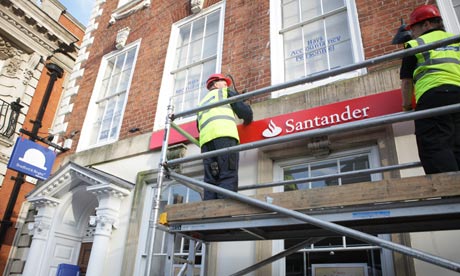Over three days in February (8-9-10), young leaders will gather in London for the One Young World summit, aiming to discuss and begin addressing major global issues of today and tomorrow, such as climate change and human rights.
The participants (born during or after 1984) are being chosen by votes on Facebook and YouTube. Once the summit begins, sessions will be streamed online and social media will be an integral part of the experience.
Can One Young World actually make a difference? This has to be more than a one-time effort. Spotlighting major issues is a good start; involving emerging leaders in devising local solutions would add to the follow-through and keep momentum going.
Wednesday 27 January 2010
Monday 25 January 2010
Pricing for online news
Will readers who routinely access publications online be willing to pay for the privilege? The Financial Times has been using metered pricing for some time. Every time a reader clicks onto the site, the "meter" starts ticking. If the reader hasn't registered with FT, he or she can read only 1 article per month for free. If the reader has registered, he or she can read 10 articles per month for free. Paid subscribers receive full access to the entire news and archive sites, with no restrictions on the number of articles that can be viewed.
So far, FT's pricing policy has served the publication well. Over time, FT has made its metering more restrictive, not less restrictive, and the publication currently has more than 120,000 paid subscribers, an increase of 22% compared with the previous year, according to Advertising Age.
Now the Times Online is introducing a pricing system for its online content, and the French Le Figaro and L’Express also have plans to charge for online access. The New York Times is readying a 2011 pricing policy for online access, as well. Will the publications succeed in building profits from what readers now regard as free sources?
So far, FT's pricing policy has served the publication well. Over time, FT has made its metering more restrictive, not less restrictive, and the publication currently has more than 120,000 paid subscribers, an increase of 22% compared with the previous year, according to Advertising Age.
Now the Times Online is introducing a pricing system for its online content, and the French Le Figaro and L’Express also have plans to charge for online access. The New York Times is readying a 2011 pricing policy for online access, as well. Will the publications succeed in building profits from what readers now regard as free sources?
Thursday 21 January 2010
Stand-alone campaign sites lose favour
 Instead of creating stand-alone web sites to support new advertising campaigns, some major advertisers are showcasing campaigns via fan and friend pages on existing social media sites.
Instead of creating stand-alone web sites to support new advertising campaigns, some major advertisers are showcasing campaigns via fan and friend pages on existing social media sites.A marketing official for Unilever tells New Media Age: 'You’ll see fewer brands creating a site for one campaign and then throwing it away. Certainly we won’t do that at Unilever any more'.
Unilever, Coca-Cola, Kellogg, Procter & Gamble and other smart marketers see consumers flocking to YouTube, Facebook, MySpace and other social media sites . . . and they realise that instead of trying to drive traffic to a stand-alone campaign site, it makes sense to take the campaign to popular sites that draw crowds. Coca-Cola is particularly interested in viral marketing via social media and crowdsourcing content as well.
This shift toward existing social media sites is not just a matter of money, it's a way of winning hearts and minds in the battle for brand preference. Kellogg's Pop Tarts brand has more than 1 million Facebook fans. That's a LOT of fans who want to read the brand's news feed.
Thursday 14 January 2010
Price match promises at DSGi
 PC World, Currys, Dixons and the other businesses under DSGi ownership are successfully using low prices to differentiate themselves during this challenging economic period.
PC World, Currys, Dixons and the other businesses under DSGi ownership are successfully using low prices to differentiate themselves during this challenging economic period.Reportedly DSGi companies sold a computer and TV set every two seconds during the yearend buying season, and turnover is increasing at a steady pace.
Dixons offers a 'price match promise', telling customers that there's 'no need for a sale--we price match all of our competitors' sale prices'.
Currys has a pricing promise it calls 'price match plus 10% of the difference'. If a customer finds the identical item selling for less, Currys will match the lower price and give the customer an additional 10% of the difference between the Currys price and the competing price.
PC World offers a similar pricing promise, which extends up to 7 days after the date of purchase.
Will price matches be as powerful a competitive tool once the economy recovers?
Monday 11 January 2010
Santander strengthens bank branding
 Santander, based in Spain, has brought its brand to UK high streets by buying and replacing local brands like Abbey, Bradford & Bingley and Alliance & Leicester.
Santander, based in Spain, has brought its brand to UK high streets by buying and replacing local brands like Abbey, Bradford & Bingley and Alliance & Leicester.This has not been an overnight process, as I wrote last July, but branding experts do note that putting the Santander brand on so many banks has happened unusually quickly. Santander's strength during the economic crisis is one reason why it can move with such speed and determination.
Customers can't help but notice the change. The key element that determines their reaction to rebranding is quality of service. If Santander maintains or, ideally, improves service levels without raising fees, customers are likely to be satisfied no matter what brand the bank happens to carry.
Friday 8 January 2010
Social media: Know the rules

If anyone in your organisation tweets, blogs or uses Bebo, Facebook, YouTube or similar sites, they should know--and follow--your company's rules for interacting (with each other and with customers or other audiences) via social media. The idea is to promote transparency and engage your audiences on an ongoing basis, within appropriate legal and competitive boundaries.
To get an idea of what social media policies look like, click through the database of the Social Media Governance site. You'll see links to guidelines from BT, the BBC, UK government and other organisations.
ASDA, the discount retail giant, is moving into social media in a big way. Its media centre page shows links to the many ASDA personnel who are on Twitter, for instance. As part of its push for transparency, ASDA invites public comments on its blogs...subject to common-sense rules you can read here.
Company policies should be similarly straightforward and easy to understand. Mashable offers a listing of 10 rules to follow in writing your rules.
Monday 4 January 2010
Marketing thought leadership at INSEAD
For inspiration and analysis, put INSEAD Knowledge on your bookmark list and check back often for articles about marketing issues such as visual equity, viral marketing and sales/marketing balance.
I also recommend watching some of the interviews with the professors, which offer additional insights and ideas. A time investment of just 10 minutes (or less) may pay off in your next big marketing idea of 2010!
I also recommend watching some of the interviews with the professors, which offer additional insights and ideas. A time investment of just 10 minutes (or less) may pay off in your next big marketing idea of 2010!
Saturday 2 January 2010
Ocado delivers higher sales
 Despite snow snarling deliveries amid sharply higher seasonal demand, Ocado has turned in a winning performance, with sales up an eye-popping 30 percent in December. Considering the challenging economic climate, Ocado's accomplishment is especially impressive.
Despite snow snarling deliveries amid sharply higher seasonal demand, Ocado has turned in a winning performance, with sales up an eye-popping 30 percent in December. Considering the challenging economic climate, Ocado's accomplishment is especially impressive.Ocado's appeal is not just convenience but also special pricing on many items. The company will match Tesco's prices on certain merchandise and in addition offers deals on Waitrose items--pricing not available in the stores.
With careful marketing and top-notch customer service, Ocado is aiming to build profits and market share in 2010, when it is widely expected to go public.
Subscribe to:
Posts (Atom)

